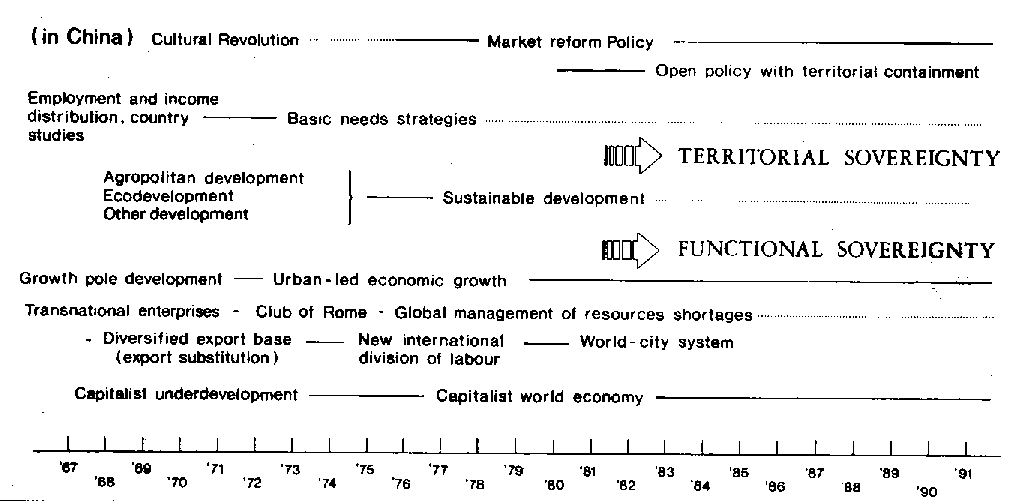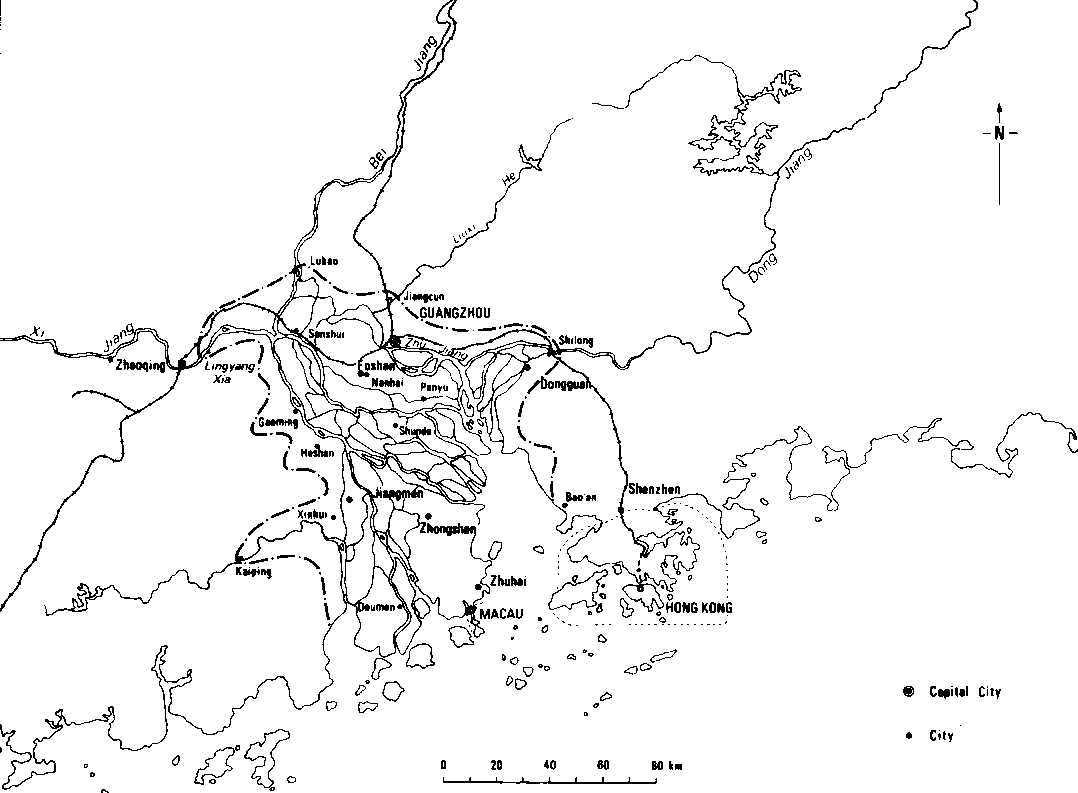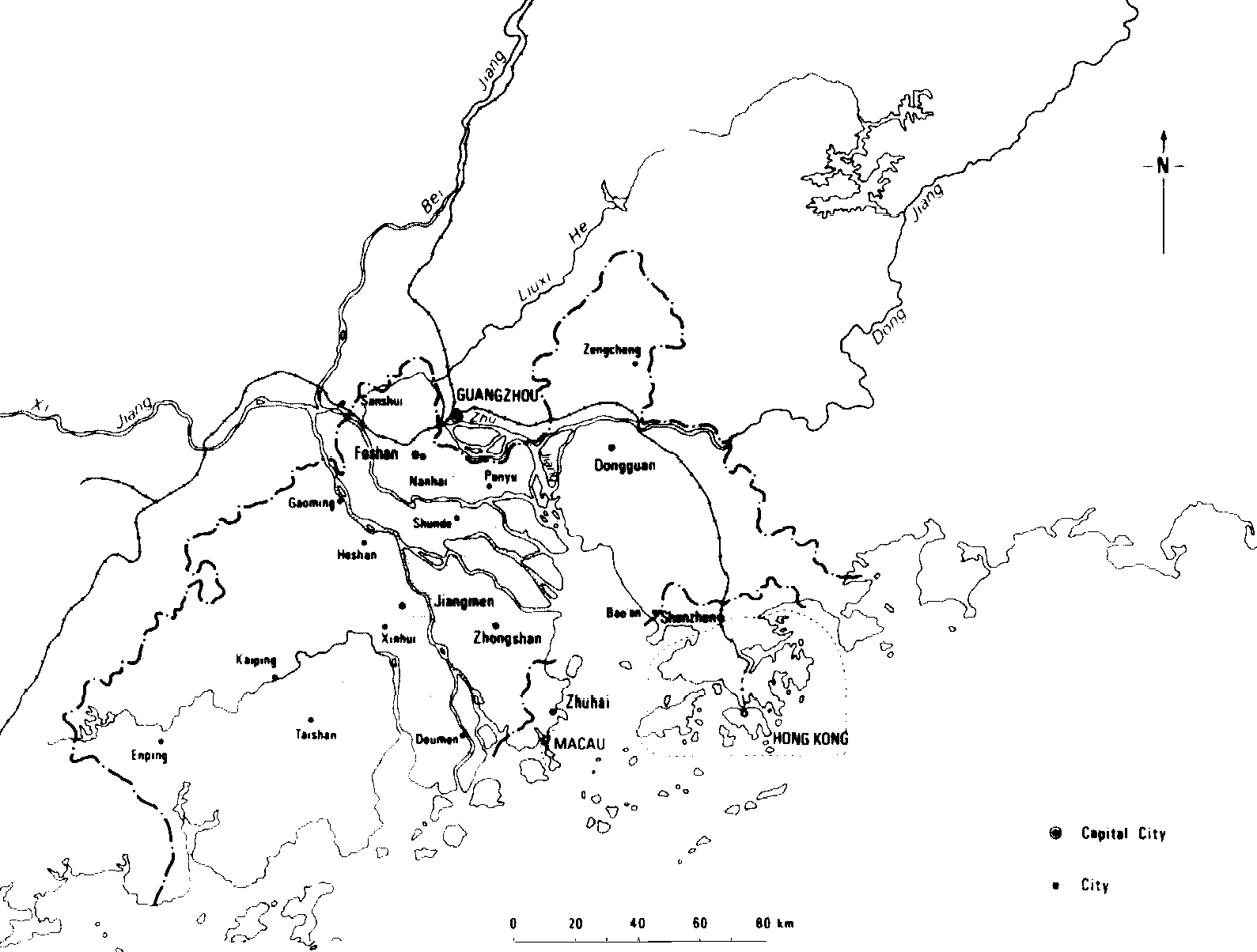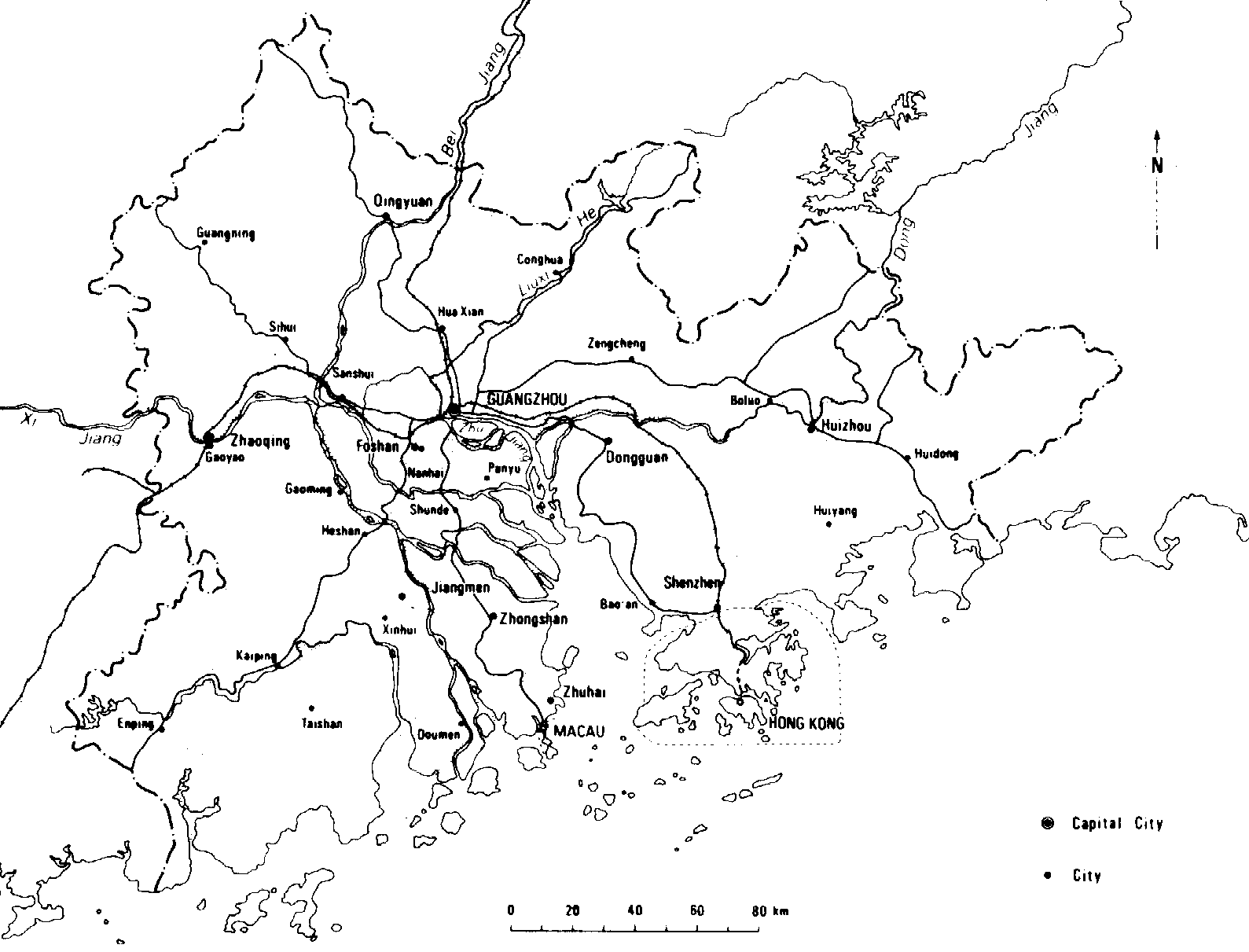This is the old United Nations University website. Visit the new site at http://unu.edu
The Hong Kong-Zhujiang Delta and the world city system
Introduction
The Zhajiang Delta and its cities
The world city hypothesis and Zhajiang Delta
cities
Territorial containment of a functional world
city phenomenon
Conclusion
Acknowledgements
References
David K. Y. Chu
In the 1960s and the early 1970s, most scholarly publications on economic development and regional planning in the capitalist world focused on the role of cities or city systems in relation to their catchment areas. The importance of cities in integrating national and regional economies was fundamental in many of these endeavours (Myrdal, 1957; Hirschman, 1958; Berry, 1972; Friedmann, 1973). According to many of these views, the most basic advantage of cities stems from the reduction of distance, or the elimination of friction of space. This advantage is implicit in urban concentration, and cities are thus centres of change and economic growth (Dwyer, 1972). In any given region, the largest urban centre forms the core, while its catchment area, including the secondary cities, towns, and countryside, forms the periphery. Through either forward or backward linkages or both, a process of polarization takes place, whereby capital, technology, innovation, and people are increasingly drawn to the core. Increasing concentration of resources enables the core to expand and grow, often at the expense of the periphery. Authors of the diffusion school assert that, at some point in time, the process of economic development begins to trickle down, leading to the eventual growth and development of the periphery (Hirschman, 1958; Berry, 1972). Others contend that polarization takes precedence over dispersion, with the likelihood of the latter not occurring at all. The result is an unimpeded expansion of the city at the core, leaving the periphery as underdeveloped as ever. These arguments are notably seen in the writings of the school of capitalist underdevelopment (Frank, 1969; Amin, 1974).
China presents a very different model from that of the diffusion school or the school of underdevelopment. First of all, it deviated from the norm by employing the Stalinist model of heavy industrial development and urbanization in the late 1950s. Chinese urbanization was then influenced by counter-urbanization measures to restrain the growth of cities throughout the Cultural Revolution. In terms of industrialization, its strategy was that of "walking on two legs": the modern and the traditional were both found useful (Dumont, 1973; Gurley, 1976; Wong, 1976). Agro-development with a heavier emphasis on the rural side was pursued to overcome the contradictions between town and countryside. The anti-urban bias of the Chinese model was carried forward to the mid-1970s until the death of Mao.
Towards the end of the 1960s, disillusioned by the progress made in general and in developing countries in particular, development specialists began to question the raison d'être of economic growth for its own sake and to acknowledge the impossibility of meeting rising expectations with known resources. Seers (1969) raised some fundamental questions concerning the "meaning" of development, especially the variance between per capita income and other yardsticks of development such as income distribution, unemployment, and degree of inequality. For Friedmann and Weaver (1979), Seer's speech marked the beginning of the end of a decade-long search for development strategies using conventional models for understanding development.
From the mid-1970s onwards, the search for ways of ameliorating the consequences of unequal development has not been for simple departures from "polarized development" or "rural-urban" frameworks but for different concepts altogether. Instead, in conjunction with the trends of the international division of labour, the growth of transnational corporations, and the recognition of an emerging world economy, this new phase of evolving a development doctrine was fashioned in a series of scholarly works and reports.
A milestone is Wallerstein's formulations on the modern world system (Wallerstein, 1974, 1979, 1984). His works project a new role for cities as part of the larger historical movement of industrial capitalism. The new world system of production and markets is spatially articulated through a global network of cities - the world cities. Life in these cities reflects to a considerable extent "the mode of their integration into the world economy...; the mode of world system integration... will affect in determinate ways the economic, social, spatial and political structure of world cities and the urbanizing processes to which they are subject" (Friedmann and Wolff, 1982:309313). The position of a particular city in the world city hierarchy could be measured by the number of headquarters of transnationals and other supporting corporate services in relation to the new international division of labour (Cohen, 1981). An essential feature of this new transnational-motivated ideology is its global approach to the development issue, where global reorganization is increasingly oblivious to national boundaries (Henderson and Castells, 1987). This feature is also reflected in the series of reports produced by the Club of Rome calling for a global approach to tackling shortages of resources and the diversification of industries (Meadows et al., 1972).
Rather than putting a heavy emphasis on the role of the transnationals and the international circulation of capital and technology in economic development, the International Labour Office (ILO) called for a different approach to development in the mid-1970s (ILO, 1974). It put the emphasis on self-reliance in development, chiefly by weakening a country's tie to the world economy of transnationals, because the latter offer no chance whatsoever of meeting the ever more distressing problems of joblessness and landlessness in developing countries. This implies a territorially based, autonomous development that would give priority to raising agricultural production and to meeting the basic needs of the masses (ILO, 1976).
At the same time as the ILO was preparing its conferences, a set of independent reports was published, related in one way or another to the United Nations. They all stressed the importance of self-reliance ("Cocoyoc Declaration," 1974). Friedmann and Douglass (1975) proposed an "agropolitan" strategy in order to integrate rural with urban development, the countryside with cities. To this end, they considered the creation of a parallel economy: a wage-goods economy in the domestic market existing side by side with an export-oriented, internationally competitive economy based on a cellular principle whose smallest self-governing unit was the agropolitan district. This proposal was followed by Sachs's concept of ecodevelopment (Sachs, 1976), which combined basic needs strategies with an environmental ethic gleaned from, among others, the UN Stockholm Conference of 1972. Ecodevelopment is focused primarily on the rural aspects of development; it is directed at the rural poor in whom the transnationals have only minimal interest. It thus lends itself to engineering a somewhat similar but rural-urban embracing and environmentally conservative doctrine - sustainable development (Pearce, 1988; Barbier,1989).
The different strands of thought about development since the 1960s, though interrelated, converge upon two different forms of social integration: territorial and functional. This was first proposed in 1979 by Friedmann and Weaver (fig.13.1). It is a unity of opposites. The two forms not only complement but also contradict each other. This is especially so when we study the Zhujiang Delta city system. There is evidence to suggest that this city system has become a spatial expression of a bitter struggle between the two contradictory and yet complementary principles. China is basically a physical entity with clear-cut territorial sovereignty. The functional sovereignty that the transnationals represent expresses itself in the form of the international division of labour. The transnationals are in the lead in global organization and technology, which China lacks. The challenge faced by China in the 1980s was to find ways to accommodate the transnationals and the world city system within its jurisdiction.
Striking similarities may be found between the "agropolitan" strategy outlined by Friedmann and Douglass (1975) and what China experienced in the 1980s. After 1986, Zhao Ziyang's strategy of "Liangtou Zaiwai" (i.e. both market and raw material supply are external), and taking a position of full-fledged integration with the transnationals, was unacceptable to China and its leaders. The strategy vanished immediately after his downfall in 1989. Other than this short spell of open discussion encouraged by Zhao and his followers, the consensus reached among Chinese leaders and leading theoreticians is that China is unique and that the foundation of China's economy is agriculture. Consequently, basic needs must be addressed first, even before industrialization or opening to the world economy. Chen Yun's analogy concerning China's economic reforms likened the market mechanism in socialism to a caged bird that must be harnessed by central planning. His remark is just as important as Deng Xiaoping's remark that China must open to the world.
China's own development doctrine and its resistance to accepting the essence of economic development thinking, related to the globalization of factors of production and markets as well as the emergence of a world city system, have had profound repercussions on China's economic development in general and the Zhujiang Delta urban system in particular. The following sections outline the development of Zhujiang Delta and its cities over the past decades, and then analyse the characteristics of the Zhujiang Delta city system, using Friedmann's framework of the world city hypothesis. There follows a discussion on the theories outlined above in the context of China's unique political, historical, and cultural ways of viewing a regional, open city system, and its means of harnessing such a phenomenon.
Fig. 13.1 Streams in development doctrine and competitive paradigms (Source: Modified from Friedmann and Weaver, 1979)

The Zhajiang Delta and its cities
Definitions of the Zhujiang Delta
Unlike Guangdong province, the Zhujiang Delta lacks an official delimitation and definition (Zheng, 1991). Geomorphologically, the Zhujiang river basin is drained by Xi Jiang, Bei Jiang, and Dong Jiang. For centuries, Xi Jiang, the largest of the three with 80 per cent of the total flow capacity (about 3,020 billion m3 according to Qiao, 1981) and 90 per cent of the silt load (83 million tonnes, according to Liu et al., 1982), has been depositing sand and silt into the deltaic plain because the velocity of the water is greatly reduced when the rivers empty into the Zhujiang estuary. The Zhujiang region is thus a composite delta of the three rivers (fig. 13.2). As the lower courses of Xi Jiang and Bei Jiang are connected, the total area of their deltas is about 5,700 km2. Separated from the Xi and Bei Jiang delta by Shizi Yang is the Dong Jiang delta, which is only 250 km2 (Chen, 1978). The two deltas were linked up during the process of sedimentation, as with many other distributaries intersecting with one another.
Based on the relationship between tide and stream flow, the Zhujiang delta can be divided into a flood zone, a transitional zone, and a tidal zone (Wong and Tong, 1984). The flood zone is the uppermost section of the delta, beyond Xi Xian Jiao and Shilong. Since it is furthest away from the sea, the effects of tides are minimal and fluvial processes are more prominent. In the transitional zone between the flood zone and the tidal zone, the actions of both tides and rivers are important. The tidal zone stretches from the coastal region to Guangzhou and Jiangmen. Because of its proximity to the sea, the actions of tides are significant, with two high tides and two low tides every day. During high tides, the rate of the freshwater flow is much reduced and sedimentation occurs. The coastline of the delta is thus advancing seawards at an average rate of about 75-100 m per year.
Fig. 13.2 The Zhajiang Delta demarcated by physical characteristics (Source: Personal communication with Zheng)

Others may identify a second definition of the Zhujiang Delta, somewhat looser but still based on the physical geography. This includes the river basins drained by the lower reaches of the various rivers and islands encircled by the deposits. Under this definition, the delta is not an extensive flat area of low relief. It has about 300 hills of different heights, mostly ranging from 10 m to 300 m (Lu and Ye, 1981). The highest peaks are Wuqui Shan in the south (500 m) and Huangyang Shan in the west (591 m).
The common definition of the Zhujiang Delta is not very specific. It refers to the cities and counties drained by the lower reaches of Xi Jiang, Bei Jiang, and Dong Jiang. The common conception of the Zhujiang Delta (fig. 13.3) includes seven municipalities and seven counties, totalling 14,100 km2 (7.92 per cent of the total area of Guangdong).
Historically, these cities and counties may have been under different district governments or directly ruled by the provincial government in Guangzhou. The delta has not been governed by a regional authority and an official definition is lacking. For the sake of deciding which counties should be eligible to offer preferential treatment to foreign investment, the "Zhujiang Delta Open Economic Region" was officially demarcated in January 1985 (fig. 13.4). The district so demarcated included 12 counties, with a total area of 22,800 km2. However, Guangzhou, a designated coastal "open city,'' and the two Special Economic Zones (SEZs) of Shenzhen and Zhuhai were excluded. In October 1987 the central government of China revised the Zhujiang Delta Open Economic Region so as to include more cities as well as additional counties. Under the new definition, the Zhujiang Delta (called the "large delta") includes 7 municipalities and 21 xians with a total area of 42,600 km2 (fig. 13.5), but Guangzhou urban districts and the Shenzhen and Zhuhai SEZs are still not included.
Even taking the broadest official definition of the Zhujiang Delta (i.e. the October 1987 "Zhujiang Delta Open Economic Region" definition), meaningful analysis of its urban development is difficult because the economic-political definition of the Zhujiang Delta employed by the PRC government excludes Hong Kong and Macau. These territories are under British and Portuguese administration, respectively, and will revert to China in 1997 and 1999, respectively.
The definition of the Zhujiang Delta employed in this chapter thus includes the PRC Zhujiang Delta Open Economic Region demarcated by the newest and broadest official definition, Guangzhou, Shenzhen, and Zhuhai as well as Hong Kong and Macau.
Fig. 13.3 The common conception of the Zhajiang Delta (Source: Compiled from Zheng, 1991:1, and personal communication)

Fig. 13.4 Zhujiang Delta Open Economic Region, 1985 (Source: Compiled from Zheng 1991:5, and personal communication)

Fig. 13.5 Zhujiang Delta Open Economic Region, 1987 (Source: Compiled from Zheng 1991:5, and personal communication)

Urban development in the Zhujiang Delta
Before 1949, although the Zhujiang Delta was under three different governments (namely the Kuomintang Chinese government, the British colonial government of Hong Kong, and the Portuguese Macau government), free movement of goods, people, and capital between the three areas was unobstructed because both Hong Kong and Macau are free ports. Functionally, all the cities in the Zhujiang Delta were integrated into one urban system, with Guangzhou as the largest and the most prosperous. It was and still is the capital of Guangdong province and has been the most important seaport in Guangdong for over 2,000 years. Macau and Hong Kong were specialized cities of a lower order than Guangzhou, serving as outposts and entrepôts for colonial trade (Chu and Chiu, 1984). Other cities and towns in the Zhujiang Delta were not only market towns for their nearby catchment areas but localized centres of capital accumulation. Handicraft industries and trading in silk and cotton textiles were quite significant in Shunde and Foshan. Overseas Chinese invested heavily in their home towns.
The year 1949 witnessed the rise to power of the current mainland Chinese government. The civil war between the Kuomintang and the Communist Party and the victory of the latter drove waves of migrants from China to Hong Kong (and, to a lesser extent, to Macau). The sudden influx of migrants resulted in Hong Kong's population exceeding 1 million, which surpassed Guangzhou's (table 13.1). The free movement of people did not stop until 1952. The free movement of goods stopped when Communist China got involved in the Korean War and the United Nations subsequently imposed a trade embargo. From then on, Hong Kong and Macau were cut off from the rest of the Zhujiang Delta and developed independently. Other than a few waves of uncontrolled "refugees" swarming from the Zhujiang Delta to Hong Kong, interactions between the PRC Zhujiang Delta and the two colonial territories were kept to a minimum. Border trade was allowed but was insignificant. Trade and visits to China were made easier when spring and autumn trade fairs began to be held in Guangzhou in 1957.
Between 1957 and 1978, the PRC Zhujiang Delta cities grew slowly because of the "under-urbanization" policy of China. Strict household registration and the system of grain rationing prevented free rural-urban migration. Large-scale investment projects in the delta's industries and infrastructure were few because of (a) the perceived susceptibility to naval attack, (b) the proximity to the capitalist enclaves of Hong Kong and Macau, (c) Mao's purported endeavour to eradicate the disparities between the coastal regions and interior areas, and (d) out-migration (legal and illegal) to Hong Kong and Macau Consequently, the average annual rate of urban growth of the inner Zhujiang Delta was 0.75 per cent per annum (Xu and Li, 1990). However, Guangzhou's supremacy remained unchallenged in the PRC Zhujiang Delta in terms of its population size, industrial output, or trading volume.
Table 13.1 The relative size of cities in the Zhujiang Delta urban system, 19491990 (population in thousands)
| City | 1949a | 1957a | 1978 | 1984a | 1990b |
| Dongguan | 37 | 91 | 115 | 177 | 195 |
| Foshan | 148 | 134 | 189 | 230 | 303 |
| Guangzhou | 1,414 | 1,825 | 2,065 | 2,486 | 2,914 |
| Hong Kong | 1,860 | 2,790 | 4,703 | 5,398 | 5,859 |
| Huizhou | 38 | n.a. | 84 | 108 | 161 |
| Jiangmen | 65 | 103 | 126 | 160 | 219 |
| Macau | 187 | 169 | 268 | 391 | 444 |
| Qingyuan | 25 | n.a. | n.a. | 52 | 165 |
| Shenzhen | 18 | 12 | 23 | 153 | 600 |
| Zhaoqing | 39 | n.a. | 101 | 138 | 193 |
| Zhongshan | 66 | 130 | 123 | 209 | 112 |
| Zhuhai | n.a. | 4 | 13 | 68 | 132 |
Sources: PRC cities, 1949-1978 - Zheng (1991); 1984 - Statistical
Yearbook of Guangdong, p. 65;1990 -Statistical Yearbook of
Guangdong, 1991, pp. 82-85.
Hong Kong - Hong Kong Yearbook, various years.
Macau - Macau Census and Statistics Department, Yearbook of Statistics and Macau in Figures, venous years.
a. Non-agricultural population registered in Chinese
cities.
b. Official number of residents in each city.
On the southern fringe of the Zhujiang Delta, Hong Kong rose quickly in this period and became the first industrial colony in the early 1970s as well as a financial centre in the late 1970s. Hong Kong's successes are well documented (see Hsia and Chau, 1978; Jao, 1979; Hsia, 1984; Chen, 1989; Henderson, 1991). In comparison with Hong Kong, Macau's economy has made less remarkable progress, and its industrialization did not start until the mid-1970s. Macau's economy was heavily dependent on Hong Kong (Cremer, 1991). To sum up, during this period urban development in the Zhujiang Delta was uneven and two independent urban systems were to be found in the region. The Hong Kong-Macau system grew much faster than its inland counterpart.
The period 1978-1990 witnessed a process of gradual merging of the two urban systems, at least functionally if not politically. Interaction among the cities in the Zhujiang Delta grew dramatically. Hong Kong's economic and perhaps cultural influences overshadowed those of Guangzhou in the regional urban system in almost every aspect: from population size to industrial output, the value and growth of foreign trade, foreign investment, telecommunications, international flights, fashion, and pop songs. In other words, China's open policy has submitted Guangzhou and other Zhujiang cities to the dominance of Hong Kong. Like Macau, which in fact grew less dependent on Hong Kong, Guangzhou was relegated to the position of a second-order city. Other Zhujiang Delta cities can be identified as third- and fourth-order cities following the merging of the two independent city systems. Also worth mentioning is the creation of two border cities - Shenzhen and Zhuhai. From a small border town, Shenzhen, in particular, has been growing very rapidly since the early 1980s (over 30 per cent per annum). Its total population (permanent and temporary residents) is now almost half that of Guangzhou. Also, other small cities and towns have grown faster than Guangzhou. According to Xu and Li (1990), there are signs that the region's system of cities is heading towards a rank-size, log-normal, or Pareto distribution.
With the improvements of roads, railways, highway bridges, and telecommunications planned or under construction, plus rapid urbanization of the rural countryside, the functional integration of the cities, towns, and even villages in the Zhujiang Delta region will advance by leaps and bounds. By the year 2000, it will not be surprising if the region under study becomes a megalopolis comparable to other megalopolises of the world (Chu, Yeung, and Lam, 1989).
The making of the Zhujiang Delta megalopolis is now being accelerated by many factors:
• the reversion to China of Hong Kong in 1997 and of Macau in 1999;
• the completion of the first stage of the Hong Kong-Guangzhou-Macau superhighway in 1993;
• the completion of the nuclear power plant in Daya Bay in 1993, plus many other coal-fired thermal plants in the near future;
• the increasing use of new communications technology such as faxes, mobile phones, satellite TV;
• a new package of economic reforms;
• institutional and administrative reforms;
• the rationalization and commercialization of agriculture;
• industrialization, both urban and rural;
• the rise in average per capita incomes and an enlarging domestic market;
• desakota urbanization/extended metropolis.